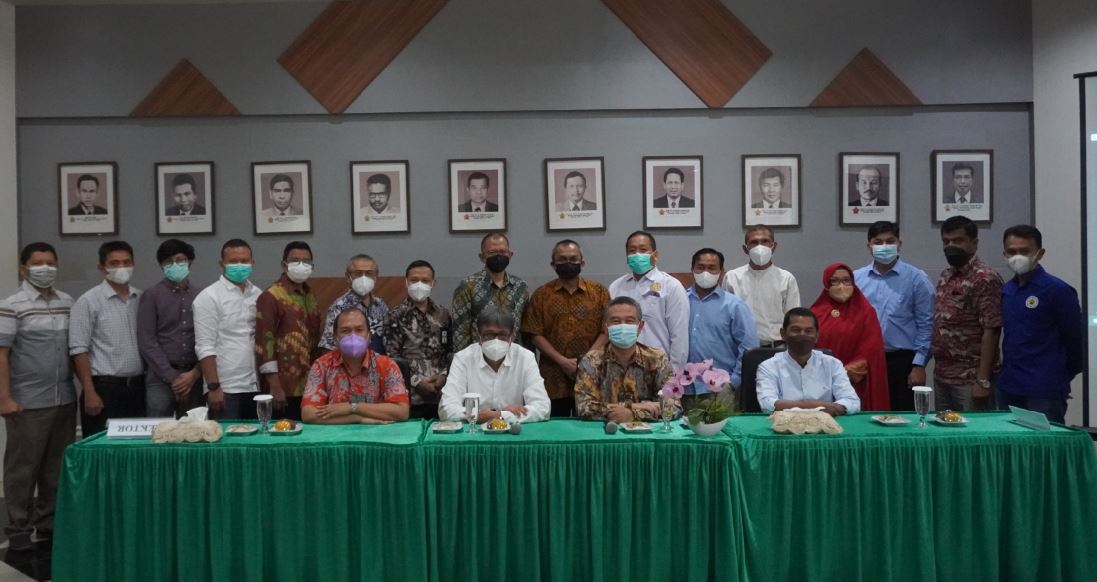Natural disasters like tsunamis, volcanic eruptions, and earthquakes have been a part of Indonesia's history from ancient times to the present. This is inevitable given Indonesia's location in the Ring of Fire. Hence, a concrete solution is needed through innovative research to mitigate and address potential disasters that would impact the fate of the wider community. Addressing these challenges, Syiah Kuala University (USK) in Banda Aceh is currently engaged in disaster research funded by LPDP's RISPRO, conducting research entitled SupeRISKa: Decision Support System for Financing and Disaster Risk Insurance Based on Threat Characteristics, led by Dr. Syamsidik.
During the Monitoring and Evaluation visit, LPDP's Research Facilitation Director, along with the team, had the opportunity to directly review the interim progress of these two research projects on Tuesday, January 18, 2022. The event began with an opening session at the AAC Dayan Dawood building, Syiah Kuala University.
In his address, USK's Rector, Prof. Dr. Ir. Samsul Rizal MEng IPU ASEAN Eng., revealed the need for improved research activities, especially considering the growing use of LPDP's managed research endowment funds by universities dedicated to community service.
"According to our data, there are currently 21 ongoing grants funded by LPDP. These consist of 1 grant for the Invitational RISPRO scheme, 1 grant for the RISPRO Competition scheme, 4 grants for RISPRO Mandatory (National Research Priorities), 1 grant funded for International Collaboration, and 14 grants for Scientific Research," stated the Rector.
He also emphasized that as one of the main pillars of the University's Tri Dharma, research and development should be stimulated not only for the advancement of knowledge but, more importantly, to have a widespread impact on society.
LPDP's Research Facilitation Director, Wisnu Sardjono Soenarso, explained that the purpose of the Monev (Monitoring and Evaluation) activity is a platform for discussion to dissect the directions, progress, and challenges faced by researchers. This represents LPDP's responsibility not only as a provider of funds but also in the guidance process until the research is completed.
LPDP's research funding commitment is a testament to the government's dedication to fostering innovation and knowledge development in Indonesia. "I want to dispel the myth that research problems in Indonesia are only about funding. Now I challenge universities and research institutions: what research do you have? Just offer your proposals, regardless of the costs; we are ready to pay," he asserted.
Aside from monitoring and evaluating the funding for the Invitational RISPRO, the team also concurrently monitored and evaluated the International Collaboration RISPRO funding, collaborating with the International Science Fund (DIPI) for the research titled "Toward National Standards for Technical Specifications of SARS-cOv-2 Patient Isolation Chambers," led by Prof. Dr. Ir. Samsul Rizal MEng IPU ASEAN Eng.
Following the opening meeting at the AAC Dayan Dawood building, the reviewer team was divided to visit two research locations: at the Faculty of Engineering for the Patient Isolation Chamber-related research and at the Tsunami and Disaster Mitigation Research Center (TDMRC) for the SUPERISKA research.
SUPERISKA: Strategic Measures to Counter Fiscal Risks
Indonesia's geographical condition places it among the 39 most disaster-prone countries globally. The projected economic losses due to natural disasters are estimated at Rp. 22.8 trillion per year, while government funding for significant disaster impacts is only available at around Rp3-4 trillion per year.
This means that the funding gap has and will continue to expose Indonesia to increasingly high fiscal risks from natural disasters. Hence, alternative financing involving sources beyond the state budget, such as insurance, is essential for Indonesia to build resilience against disasters.
Dr. Syamsidik's SupeRISKa research addresses these challenges through three approaches:
Formulating a disaster risk model for financing and risk insurance for State Property (BMN) and Regional Property (BMD) throughout Indonesia based on scenarios of various threat types.
Developing disaster risk financing strategies for BMN and BMD assets at both national and regional levels.
Providing a Decision Support System (DSS) for the Financing Model and Disaster Risk Insurance for BMN and BMD.
"Through this research, we hope to strengthen financial stability to ensure that regions can recover more quickly to assist the community," stated the lead researcher, Dr. Syamsidik.
This research will map at least nine types of disaster threats in financing models for BMN and BMD, including earthquakes, tsunamis, floods, landslides, forest fires, droughts, extreme weather, extreme waves, and volcanic eruptions.
The Monev presentation took place at the Tsunami and Disaster Mitigation Research Center (TDMRC), accompanied by the Secretary of the Institute for Research and Community Service (LPPM), Dr. Sulastri MSi, and remotely attended by reviewer Prof. Dr. Ir. A. M. Imran from UNHAS.
ToNS-PIC: Realizing the Safest Isolation Room Standards for Patients and Healthcare Workers
It's been nearly two years living in the pandemic era, which not only frequently results in patient losses but also affects numerous healthcare workers due to transmission within healthcare facilities. This highlights deficiencies in the isolation room standards in healthcare facilities.
This research has realized an isolation room model by first adapting to the humidity and temperature aspects of the natural properties of the COVID-19 virus. The study also investigates how the air circulation system should be configured within the isolation room to prevent virus transmission through droplets and air.
"The ultimate hope is that healthcare workers no longer need to wear complicated personal protective equipment as they do now, as the potential for transmission has been addressed through the air circulation system in the isolation room, not only for COVID-19 but also for other contagious diseases," expressed the lead researcher, Prof. Dr. Ir. Samsul Rizal MEng IPU ASEAN Eng.
The research findings aim to serve as a reference for developing isolation rooms for easily transmissible diseases in healthcare facilities across Indonesia.
The Monev participants were also invited to inspect a mock-up/isolation room sample, located at the Faculty of Engineering laboratory, Unsyiah, accompanied by USK's LPPM Chair, Prof. Dr. Taufik F Abidin SSi M Tech., and remotely attended by reviewer Dr. Bagus Nugroho from UniMelb Australia.
